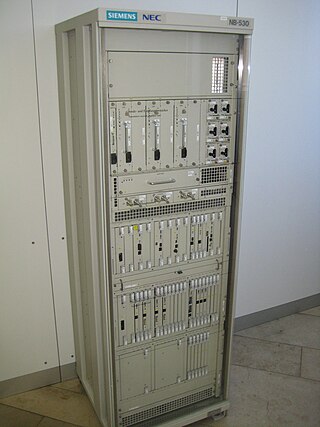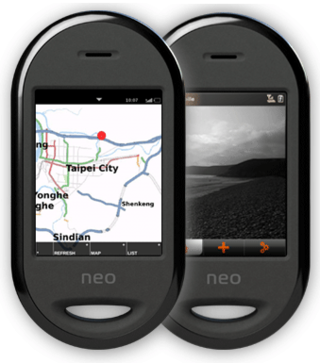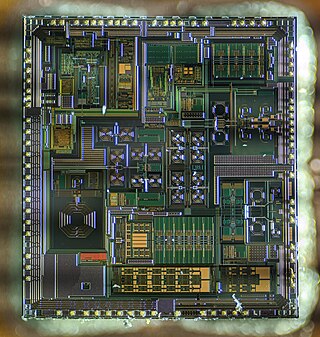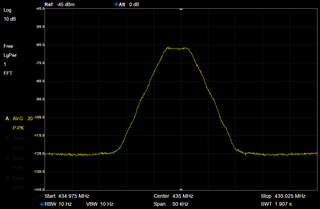
The Global System for Mobile Communications (GSM) is a standard developed by the European Telecommunications Standards Institute (ETSI) to describe the protocols for second-generation (2G) digital cellular networks used by mobile devices such as mobile phones and tablets. GSM is also a trade mark owned by the GSM Association. GSM may also refer to the Full Rate voice codec.

Software-defined radio (SDR) is a radio communication system where components that conventionally have been implemented in analog hardware are instead implemented by means of software on a computer or embedded system. While the concept of SDR is not new, the rapidly evolving capabilities of digital electronics render practical many processes which were once only theoretically possible.
Terrestrial Trunked Radio, a European standard for a trunked radio system, is a professional mobile radio and two-way transceiver specification. TETRA was specifically designed for use by government agencies, emergency services, for public safety networks, rail transport staff for train radios, transport services and the military. TETRA is the European version of trunked radio, similar to Project 25.

The base station subsystem (BSS) is the section of a traditional cellular telephone network which is responsible for handling traffic and signaling between a mobile phone and the network switching subsystem. The BSS carries out transcoding of speech channels, allocation of radio channels to mobile phones, paging, transmission and reception over the air interface and many other tasks related to the radio network.
A base transceiver station (BTS) or a baseband unit (BBU) is a piece of equipment that facilitates wireless communication between user equipment (UE) and a network. UEs are devices like mobile phones (handsets), WLL phones, computers with wireless Internet connectivity, or antennas mounted on buildings or telecommunication towers. The network can be that of any of the wireless communication technologies like GSM, CDMA, wireless local loop, Wi-Fi, WiMAX or other wide area network (WAN) technology.

Project 25 is a suite of standards for interoperable digital two-way radio products. P25 was developed by public safety professionals in North America and has gained acceptance for public safety, security, public service, and commercial applications worldwide. P25 radios are a direct replacement for analog UHF radios, adding the ability to transfer data as well as voice for more natural implementations of encryption and text messaging. P25 radios are commonly implemented by dispatch organizations, such as police, fire, ambulance and emergency rescue service, using vehicle-mounted radios combined with repeaters and handheld walkie-talkie use.
End-to-end encryption (E2EE) is a private communication system in which only communicating users can participate. As such, no one else, including the communication system provider, telecom providers, Internet providers or malicious actors, can access the cryptographic keys needed to converse. End-to-end encryption is intended to prevent data being read or secretly modified, other than by the true sender and recipient(s). The messages are encrypted by the sender but the third party does not have a means to decrypt them, and stores them encrypted. The recipients retrieve the encrypted data and decrypt it themselves. Because no third parties can decipher the data being communicated or stored, for example, companies that provide end-to-end encryption are unable to hand over texts of their customers' messages to the authorities.
An international mobile subscriber identity-catcher, or IMSI-catcher, is a telephone eavesdropping device used for intercepting mobile phone traffic and tracking location data of mobile phone users. Essentially a "fake" mobile tower acting between the target mobile phone and the service provider's real towers, it is considered a man-in-the-middle (MITM) attack. The 3G wireless standard offers some risk mitigation due to mutual authentication required from both the handset and the network. However, sophisticated attacks may be able to downgrade 3G and LTE to non-LTE network services which do not require mutual authentication.

Openmoko is a discontinued project to create a family of mobile phones that are open source, including the hardware specification, the operating system, and actual smartphone development implementation like the Neo 1973 and Neo FreeRunner. The whole project was sponsored by Openmoko Inc.

The Centre for Development of Advanced Computing, Thiruvananthapuram (C-DAC[T]) is a branch of the Indian Centre for Development of Advanced Computing based in Thiruvananthapuram.

OpenBTS is a software-based GSM access point, allowing standard GSM-compatible mobile phones to be used as SIP endpoints in Voice over IP (VoIP) networks. OpenBTS is open-source software developed and maintained by Range Networks. The public release of OpenBTS is notable for being the first free-software implementation of the lower three layers of the industry-standard GSM protocol stack. It is written in C++ and released as free software under the terms of version 3 of the GNU Affero General Public License.
C-RAN (Cloud-RAN), also referred to as Centralized-RAN, is an architecture for cellular networks. C-RAN is a centralized, cloud computing-based architecture for radio access networks that supports 2G, 3G, 4G and future wireless communication standards. Its name comes from the four 'C's in the main characteristics of C-RAN system, "Clean, Centralized processing, Collaborative radio, and a real-time Cloud Radio Access Network".

A baseband processor is a device in a network interface controller that manages all the radio functions ; however, this term is generally not used in reference to Wi-Fi and Bluetooth radios. A baseband processor typically uses its own RAM and firmware. Baseband processors are typically fabricated using CMOS or RF CMOS technology, and are widely used in radio-frequency (RF) and wireless communications.

Karsten Nohl is a German cryptography expert and hacker. His areas of research include Global System for Mobile Communications (GSM) security, radio-frequency identification (RFID) security, and privacy protection.

RF CMOS is a metal–oxide–semiconductor (MOS) integrated circuit (IC) technology that integrates radio-frequency (RF), analog and digital electronics on a mixed-signal CMOS RF circuit chip. It is widely used in modern wireless telecommunications, such as cellular networks, Bluetooth, Wi-Fi, GPS receivers, broadcasting, vehicular communication systems, and the radio transceivers in all modern mobile phones and wireless networking devices. RF CMOS technology was pioneered by Pakistani engineer Asad Ali Abidi at UCLA during the late 1980s to early 1990s, and helped bring about the wireless revolution with the introduction of digital signal processing in wireless communications. The development and design of RF CMOS devices was enabled by van der Ziel's FET RF noise model, which was published in the early 1960s and remained largely forgotten until the 1990s.
The Qualcomm MSM Interface is a proprietary interface for interacting with Qualcomm baseband processors and is a replacement for the legacy cellular extensions of the Hayes command set. With mobile chipsets, communication between the application processor and the baseband processor happens through shared memory. On PCs with data cards, QMI is exposed through USB.

M17 is a digital radio modulation mode developed by Wojciech Kaczmarski et al. M17 is primarily designed for voice communications on the VHF amateur radio bands, and above. The project received a grant from the Amateur Radio Digital Communications in 2021 and 2022. The protocol has been integrated into several hardware and software projects. In 2021, Kaczmarski received the ARRL Technical Innovation Award for developing an open-source digital radio communication protocol, leading to further advancements in amateur radio.













